Leadership and Management Report: Sainsbury's Business Environment
VerifiedAdded on 2023/01/18
|12
|2402
|55
Report
AI Summary
This report provides a comprehensive analysis of leadership and management within Sainsbury's, a major supermarket chain. It begins by defining the roles and characteristics of leaders and managers, contrasting their responsibilities and functions. The report then delves into various leadership theories and models, including situational leadership, system leadership, and contingency theory, evaluating their strengths and weaknesses in the context of Sainsbury's operations. Furthermore, the report explores the factors that impact decision-making and operational management, such as political, economic, social, technological, environmental, and legal (PESTEL) factors, along with considerations of corporate social responsibility (CSR), stakeholders, culture, and values within the business environment. The report concludes by summarizing the importance of effective leadership and management in achieving organizational objectives and adapting to various challenges within the retail sector.
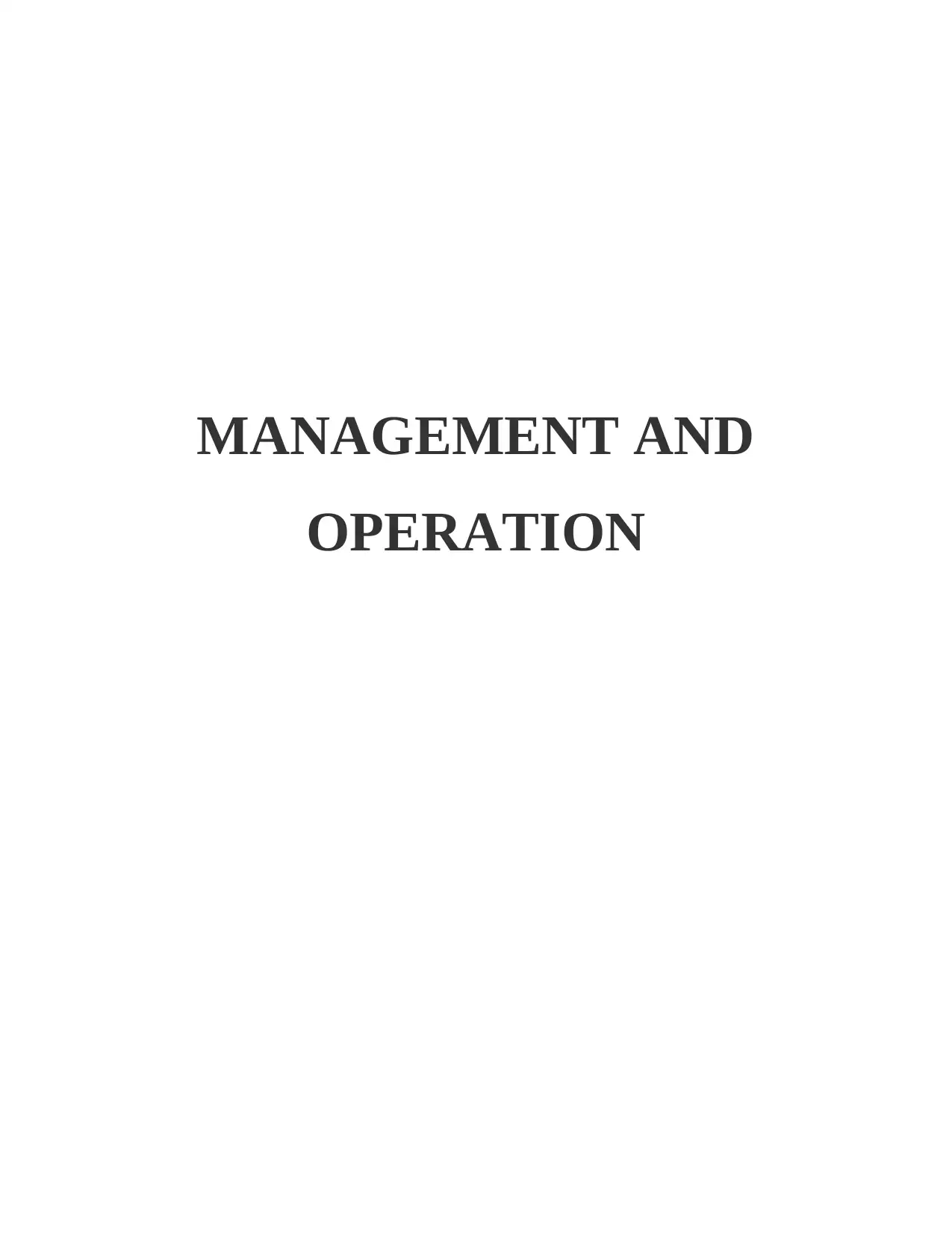
MANAGEMENT AND
OPERATION
OPERATION
Paraphrase This Document
Need a fresh take? Get an instant paraphrase of this document with our AI Paraphraser
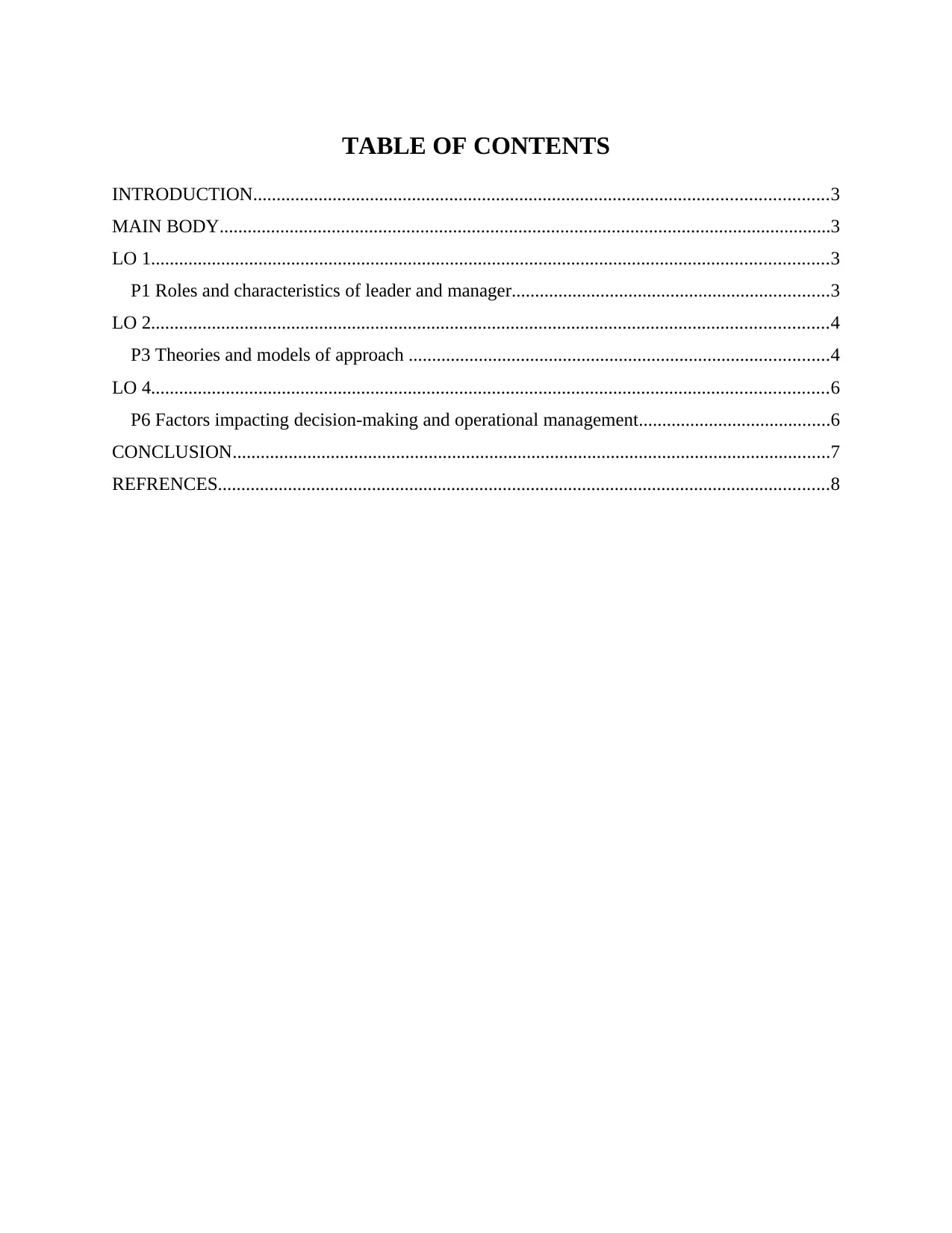
TABLE OF CONTENTS
INTRODUCTION...........................................................................................................................3
MAIN BODY...................................................................................................................................3
LO 1.................................................................................................................................................3
P1 Roles and characteristics of leader and manager....................................................................3
LO 2.................................................................................................................................................4
P3 Theories and models of approach ..........................................................................................4
LO 4.................................................................................................................................................6
P6 Factors impacting decision-making and operational management.........................................6
CONCLUSION................................................................................................................................7
REFRENCES...................................................................................................................................8
INTRODUCTION...........................................................................................................................3
MAIN BODY...................................................................................................................................3
LO 1.................................................................................................................................................3
P1 Roles and characteristics of leader and manager....................................................................3
LO 2.................................................................................................................................................4
P3 Theories and models of approach ..........................................................................................4
LO 4.................................................................................................................................................6
P6 Factors impacting decision-making and operational management.........................................6
CONCLUSION................................................................................................................................7
REFRENCES...................................................................................................................................8
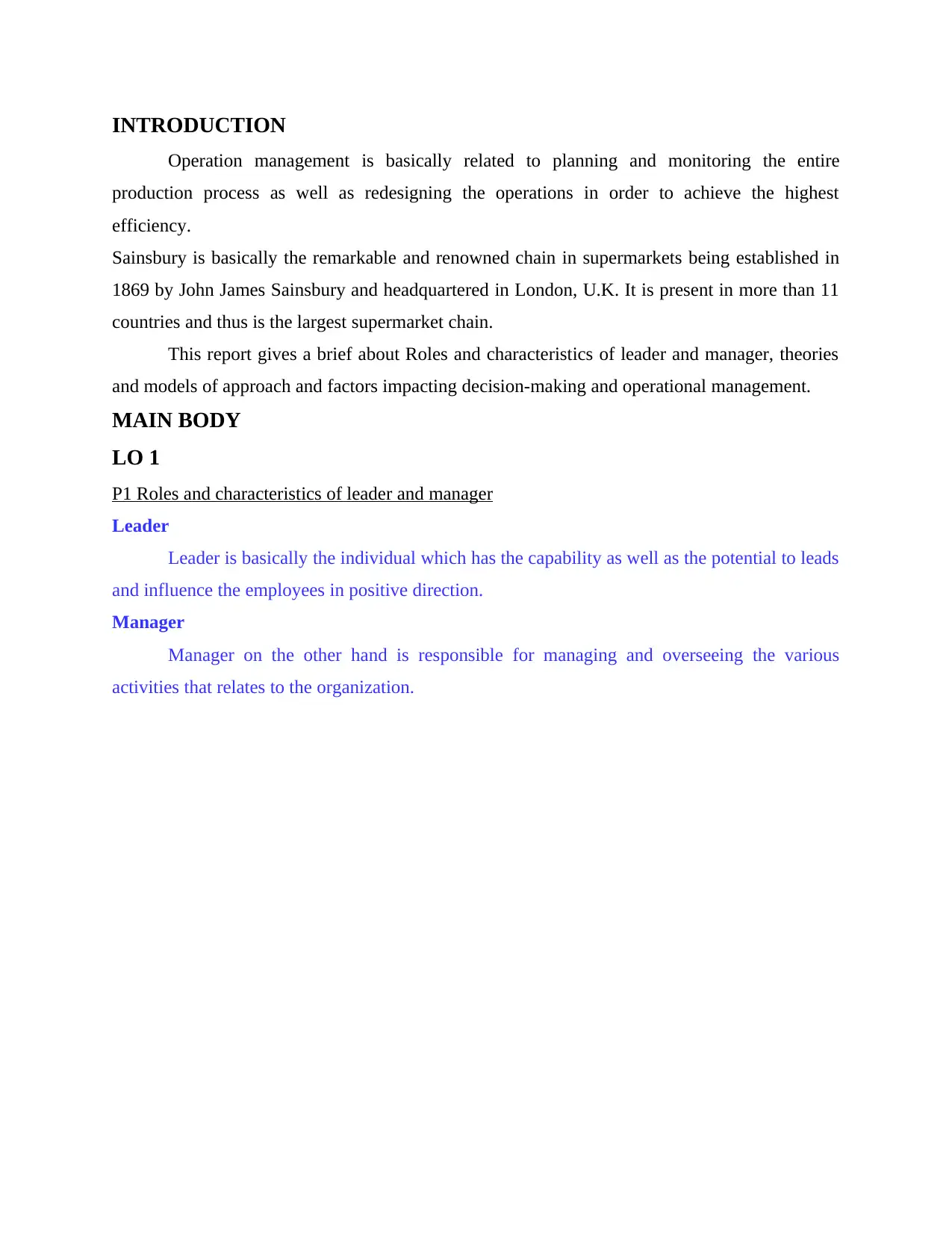
INTRODUCTION
Operation management is basically related to planning and monitoring the entire
production process as well as redesigning the operations in order to achieve the highest
efficiency.
Sainsbury is basically the remarkable and renowned chain in supermarkets being established in
1869 by John James Sainsbury and headquartered in London, U.K. It is present in more than 11
countries and thus is the largest supermarket chain.
This report gives a brief about Roles and characteristics of leader and manager, theories
and models of approach and factors impacting decision-making and operational management.
MAIN BODY
LO 1
P1 Roles and characteristics of leader and manager
Leader
Leader is basically the individual which has the capability as well as the potential to leads
and influence the employees in positive direction.
Manager
Manager on the other hand is responsible for managing and overseeing the various
activities that relates to the organization.
Operation management is basically related to planning and monitoring the entire
production process as well as redesigning the operations in order to achieve the highest
efficiency.
Sainsbury is basically the remarkable and renowned chain in supermarkets being established in
1869 by John James Sainsbury and headquartered in London, U.K. It is present in more than 11
countries and thus is the largest supermarket chain.
This report gives a brief about Roles and characteristics of leader and manager, theories
and models of approach and factors impacting decision-making and operational management.
MAIN BODY
LO 1
P1 Roles and characteristics of leader and manager
Leader
Leader is basically the individual which has the capability as well as the potential to leads
and influence the employees in positive direction.
Manager
Manager on the other hand is responsible for managing and overseeing the various
activities that relates to the organization.
⊘ This is a preview!⊘
Do you want full access?
Subscribe today to unlock all pages.

Trusted by 1+ million students worldwide
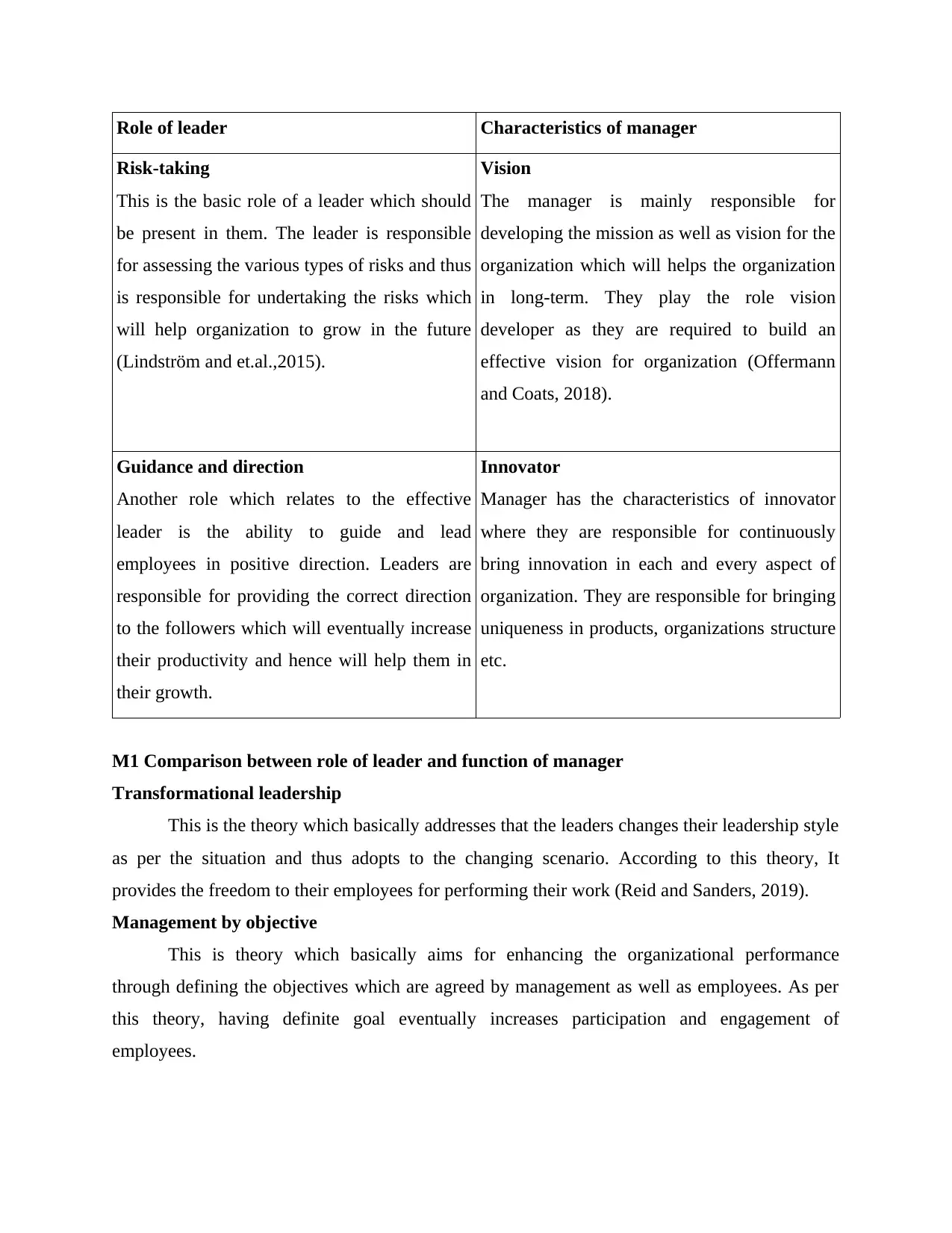
Role of leader Characteristics of manager
Risk-taking
This is the basic role of a leader which should
be present in them. The leader is responsible
for assessing the various types of risks and thus
is responsible for undertaking the risks which
will help organization to grow in the future
(Lindström and et.al.,2015).
Vision
The manager is mainly responsible for
developing the mission as well as vision for the
organization which will helps the organization
in long-term. They play the role vision
developer as they are required to build an
effective vision for organization (Offermann
and Coats, 2018).
Guidance and direction
Another role which relates to the effective
leader is the ability to guide and lead
employees in positive direction. Leaders are
responsible for providing the correct direction
to the followers which will eventually increase
their productivity and hence will help them in
their growth.
Innovator
Manager has the characteristics of innovator
where they are responsible for continuously
bring innovation in each and every aspect of
organization. They are responsible for bringing
uniqueness in products, organizations structure
etc.
M1 Comparison between role of leader and function of manager
Transformational leadership
This is the theory which basically addresses that the leaders changes their leadership style
as per the situation and thus adopts to the changing scenario. According to this theory, It
provides the freedom to their employees for performing their work (Reid and Sanders, 2019).
Management by objective
This is theory which basically aims for enhancing the organizational performance
through defining the objectives which are agreed by management as well as employees. As per
this theory, having definite goal eventually increases participation and engagement of
employees.
Risk-taking
This is the basic role of a leader which should
be present in them. The leader is responsible
for assessing the various types of risks and thus
is responsible for undertaking the risks which
will help organization to grow in the future
(Lindström and et.al.,2015).
Vision
The manager is mainly responsible for
developing the mission as well as vision for the
organization which will helps the organization
in long-term. They play the role vision
developer as they are required to build an
effective vision for organization (Offermann
and Coats, 2018).
Guidance and direction
Another role which relates to the effective
leader is the ability to guide and lead
employees in positive direction. Leaders are
responsible for providing the correct direction
to the followers which will eventually increase
their productivity and hence will help them in
their growth.
Innovator
Manager has the characteristics of innovator
where they are responsible for continuously
bring innovation in each and every aspect of
organization. They are responsible for bringing
uniqueness in products, organizations structure
etc.
M1 Comparison between role of leader and function of manager
Transformational leadership
This is the theory which basically addresses that the leaders changes their leadership style
as per the situation and thus adopts to the changing scenario. According to this theory, It
provides the freedom to their employees for performing their work (Reid and Sanders, 2019).
Management by objective
This is theory which basically aims for enhancing the organizational performance
through defining the objectives which are agreed by management as well as employees. As per
this theory, having definite goal eventually increases participation and engagement of
employees.
Paraphrase This Document
Need a fresh take? Get an instant paraphrase of this document with our AI Paraphraser
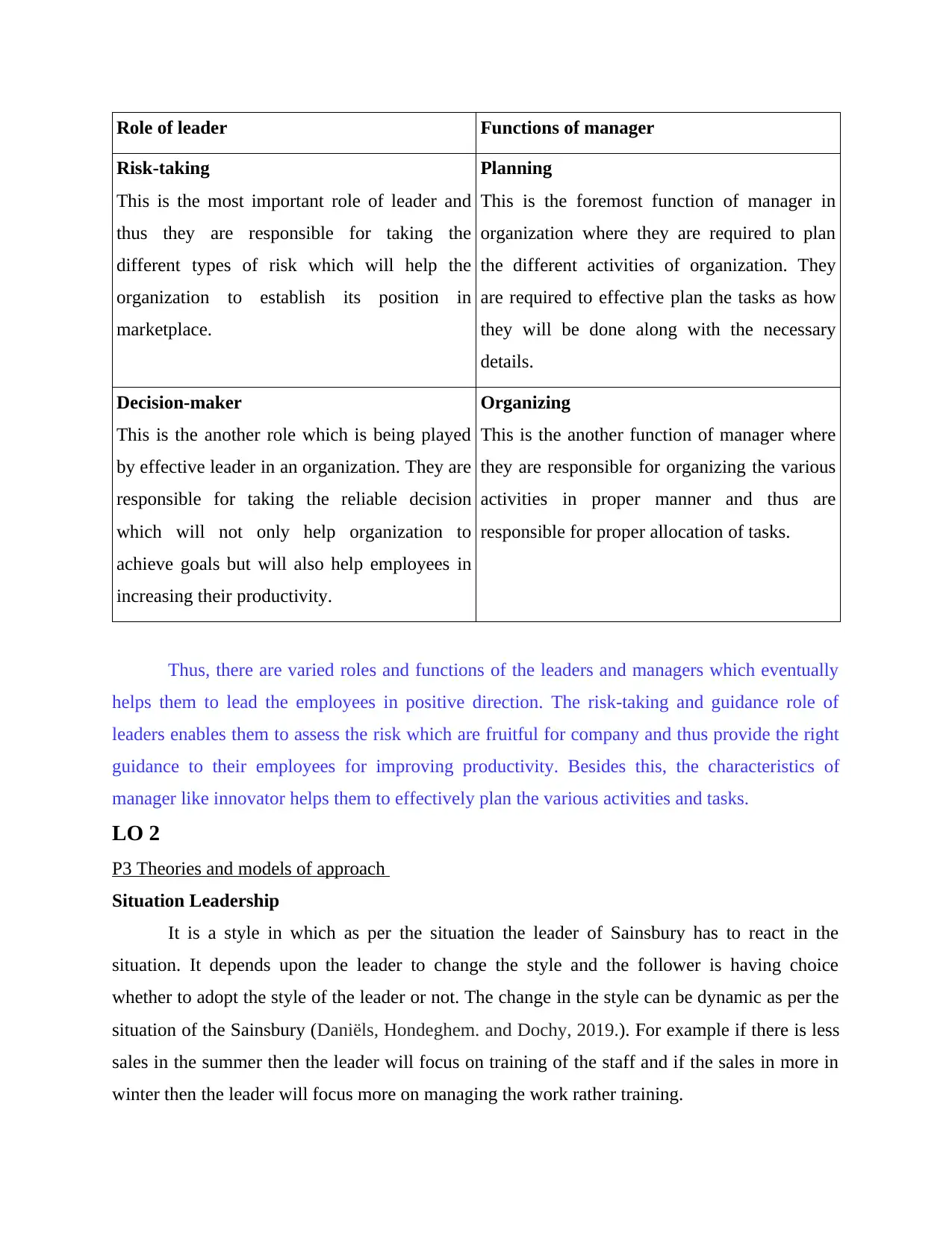
Role of leader Functions of manager
Risk-taking
This is the most important role of leader and
thus they are responsible for taking the
different types of risk which will help the
organization to establish its position in
marketplace.
Planning
This is the foremost function of manager in
organization where they are required to plan
the different activities of organization. They
are required to effective plan the tasks as how
they will be done along with the necessary
details.
Decision-maker
This is the another role which is being played
by effective leader in an organization. They are
responsible for taking the reliable decision
which will not only help organization to
achieve goals but will also help employees in
increasing their productivity.
Organizing
This is the another function of manager where
they are responsible for organizing the various
activities in proper manner and thus are
responsible for proper allocation of tasks.
Thus, there are varied roles and functions of the leaders and managers which eventually
helps them to lead the employees in positive direction. The risk-taking and guidance role of
leaders enables them to assess the risk which are fruitful for company and thus provide the right
guidance to their employees for improving productivity. Besides this, the characteristics of
manager like innovator helps them to effectively plan the various activities and tasks.
LO 2
P3 Theories and models of approach
Situation Leadership
It is a style in which as per the situation the leader of Sainsbury has to react in the
situation. It depends upon the leader to change the style and the follower is having choice
whether to adopt the style of the leader or not. The change in the style can be dynamic as per the
situation of the Sainsbury (Daniëls, Hondeghem. and Dochy, 2019.). For example if there is less
sales in the summer then the leader will focus on training of the staff and if the sales in more in
winter then the leader will focus more on managing the work rather training.
Risk-taking
This is the most important role of leader and
thus they are responsible for taking the
different types of risk which will help the
organization to establish its position in
marketplace.
Planning
This is the foremost function of manager in
organization where they are required to plan
the different activities of organization. They
are required to effective plan the tasks as how
they will be done along with the necessary
details.
Decision-maker
This is the another role which is being played
by effective leader in an organization. They are
responsible for taking the reliable decision
which will not only help organization to
achieve goals but will also help employees in
increasing their productivity.
Organizing
This is the another function of manager where
they are responsible for organizing the various
activities in proper manner and thus are
responsible for proper allocation of tasks.
Thus, there are varied roles and functions of the leaders and managers which eventually
helps them to lead the employees in positive direction. The risk-taking and guidance role of
leaders enables them to assess the risk which are fruitful for company and thus provide the right
guidance to their employees for improving productivity. Besides this, the characteristics of
manager like innovator helps them to effectively plan the various activities and tasks.
LO 2
P3 Theories and models of approach
Situation Leadership
It is a style in which as per the situation the leader of Sainsbury has to react in the
situation. It depends upon the leader to change the style and the follower is having choice
whether to adopt the style of the leader or not. The change in the style can be dynamic as per the
situation of the Sainsbury (Daniëls, Hondeghem. and Dochy, 2019.). For example if there is less
sales in the summer then the leader will focus on training of the staff and if the sales in more in
winter then the leader will focus more on managing the work rather training.
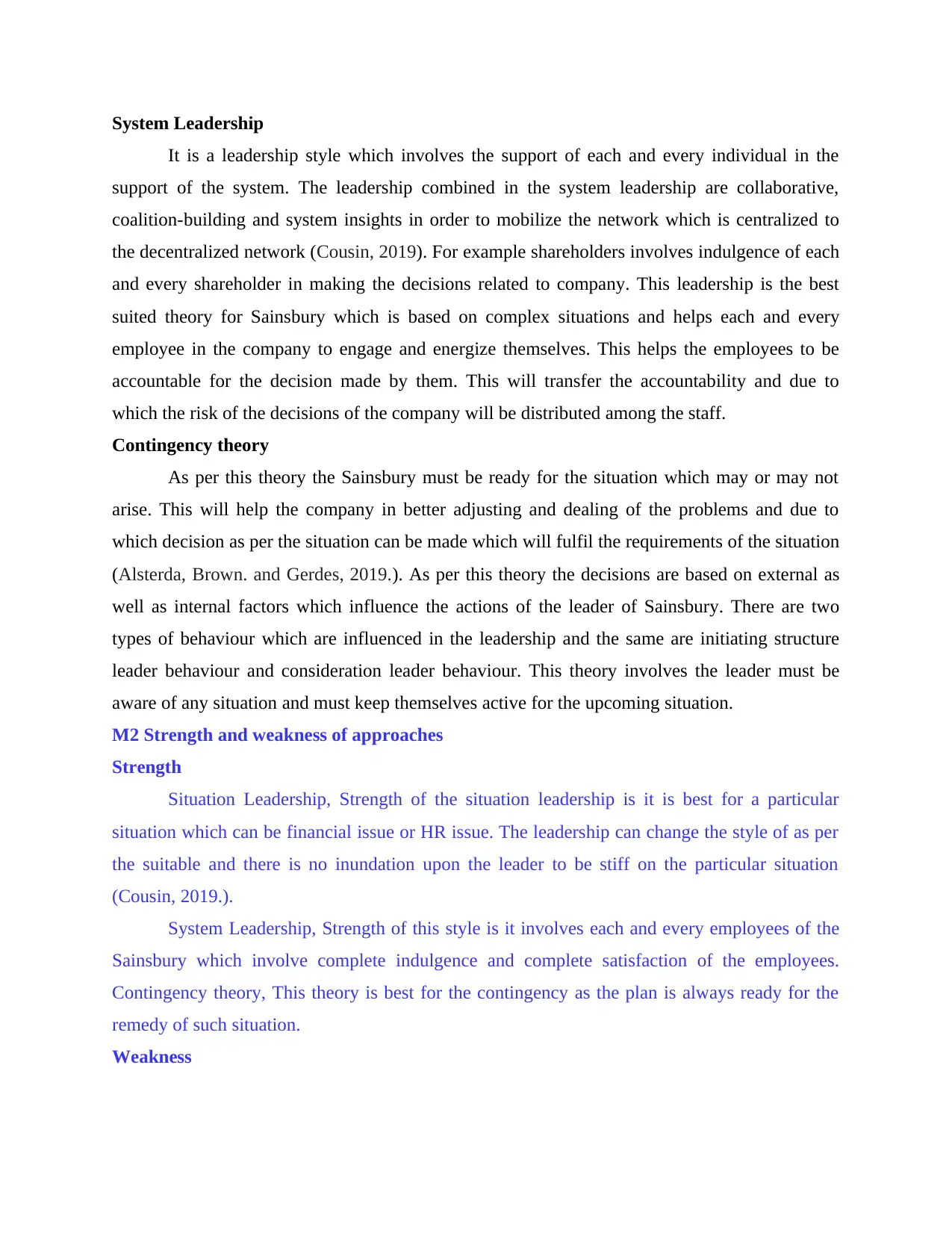
System Leadership
It is a leadership style which involves the support of each and every individual in the
support of the system. The leadership combined in the system leadership are collaborative,
coalition-building and system insights in order to mobilize the network which is centralized to
the decentralized network (Cousin, 2019). For example shareholders involves indulgence of each
and every shareholder in making the decisions related to company. This leadership is the best
suited theory for Sainsbury which is based on complex situations and helps each and every
employee in the company to engage and energize themselves. This helps the employees to be
accountable for the decision made by them. This will transfer the accountability and due to
which the risk of the decisions of the company will be distributed among the staff.
Contingency theory
As per this theory the Sainsbury must be ready for the situation which may or may not
arise. This will help the company in better adjusting and dealing of the problems and due to
which decision as per the situation can be made which will fulfil the requirements of the situation
(Alsterda, Brown. and Gerdes, 2019.). As per this theory the decisions are based on external as
well as internal factors which influence the actions of the leader of Sainsbury. There are two
types of behaviour which are influenced in the leadership and the same are initiating structure
leader behaviour and consideration leader behaviour. This theory involves the leader must be
aware of any situation and must keep themselves active for the upcoming situation.
M2 Strength and weakness of approaches
Strength
Situation Leadership, Strength of the situation leadership is it is best for a particular
situation which can be financial issue or HR issue. The leadership can change the style of as per
the suitable and there is no inundation upon the leader to be stiff on the particular situation
(Cousin, 2019.).
System Leadership, Strength of this style is it involves each and every employees of the
Sainsbury which involve complete indulgence and complete satisfaction of the employees.
Contingency theory, This theory is best for the contingency as the plan is always ready for the
remedy of such situation.
Weakness
It is a leadership style which involves the support of each and every individual in the
support of the system. The leadership combined in the system leadership are collaborative,
coalition-building and system insights in order to mobilize the network which is centralized to
the decentralized network (Cousin, 2019). For example shareholders involves indulgence of each
and every shareholder in making the decisions related to company. This leadership is the best
suited theory for Sainsbury which is based on complex situations and helps each and every
employee in the company to engage and energize themselves. This helps the employees to be
accountable for the decision made by them. This will transfer the accountability and due to
which the risk of the decisions of the company will be distributed among the staff.
Contingency theory
As per this theory the Sainsbury must be ready for the situation which may or may not
arise. This will help the company in better adjusting and dealing of the problems and due to
which decision as per the situation can be made which will fulfil the requirements of the situation
(Alsterda, Brown. and Gerdes, 2019.). As per this theory the decisions are based on external as
well as internal factors which influence the actions of the leader of Sainsbury. There are two
types of behaviour which are influenced in the leadership and the same are initiating structure
leader behaviour and consideration leader behaviour. This theory involves the leader must be
aware of any situation and must keep themselves active for the upcoming situation.
M2 Strength and weakness of approaches
Strength
Situation Leadership, Strength of the situation leadership is it is best for a particular
situation which can be financial issue or HR issue. The leadership can change the style of as per
the suitable and there is no inundation upon the leader to be stiff on the particular situation
(Cousin, 2019.).
System Leadership, Strength of this style is it involves each and every employees of the
Sainsbury which involve complete indulgence and complete satisfaction of the employees.
Contingency theory, This theory is best for the contingency as the plan is always ready for the
remedy of such situation.
Weakness
⊘ This is a preview!⊘
Do you want full access?
Subscribe today to unlock all pages.

Trusted by 1+ million students worldwide
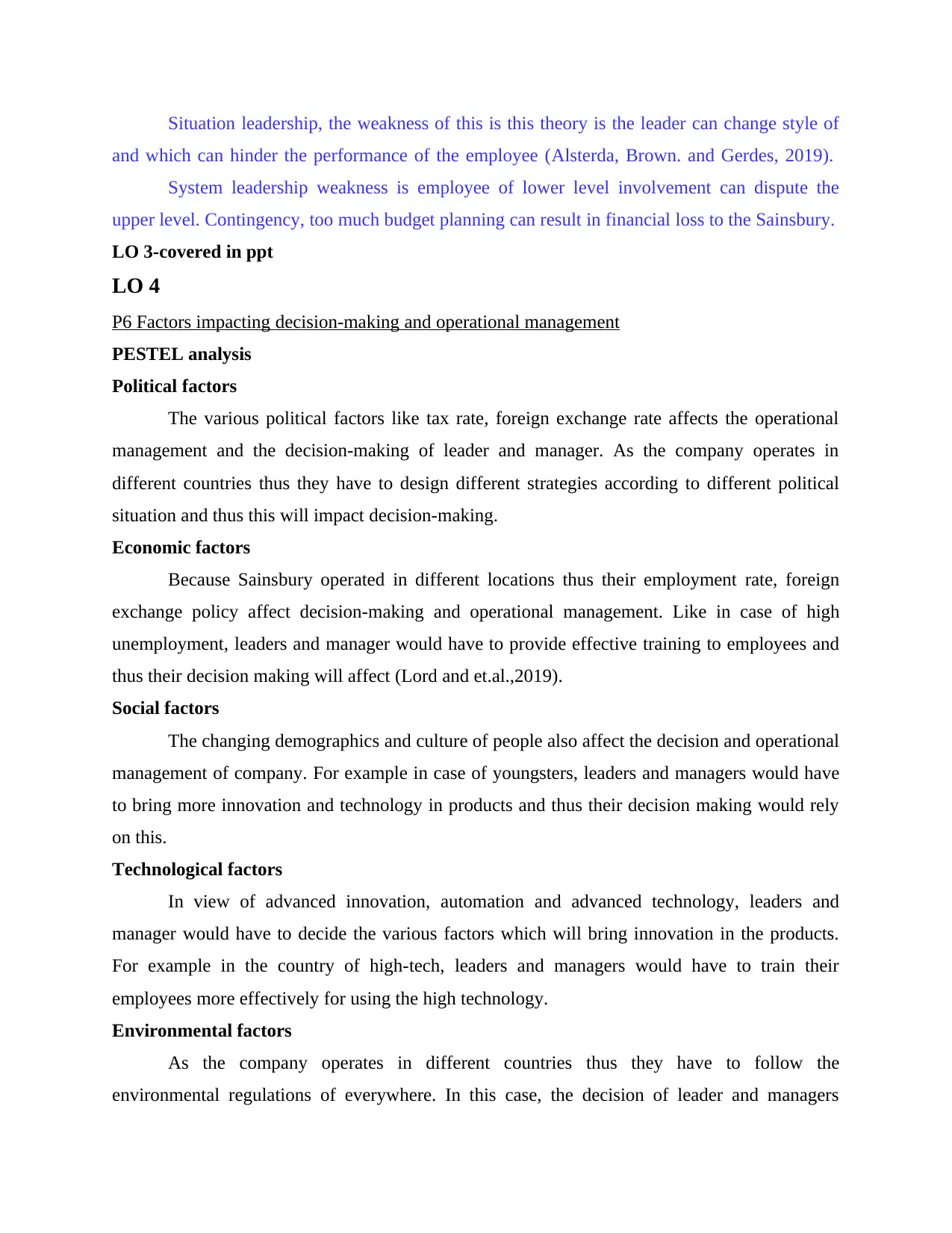
Situation leadership, the weakness of this is this theory is the leader can change style of
and which can hinder the performance of the employee (Alsterda, Brown. and Gerdes, 2019).
System leadership weakness is employee of lower level involvement can dispute the
upper level. Contingency, too much budget planning can result in financial loss to the Sainsbury.
LO 3-covered in ppt
LO 4
P6 Factors impacting decision-making and operational management
PESTEL analysis
Political factors
The various political factors like tax rate, foreign exchange rate affects the operational
management and the decision-making of leader and manager. As the company operates in
different countries thus they have to design different strategies according to different political
situation and thus this will impact decision-making.
Economic factors
Because Sainsbury operated in different locations thus their employment rate, foreign
exchange policy affect decision-making and operational management. Like in case of high
unemployment, leaders and manager would have to provide effective training to employees and
thus their decision making will affect (Lord and et.al.,2019).
Social factors
The changing demographics and culture of people also affect the decision and operational
management of company. For example in case of youngsters, leaders and managers would have
to bring more innovation and technology in products and thus their decision making would rely
on this.
Technological factors
In view of advanced innovation, automation and advanced technology, leaders and
manager would have to decide the various factors which will bring innovation in the products.
For example in the country of high-tech, leaders and managers would have to train their
employees more effectively for using the high technology.
Environmental factors
As the company operates in different countries thus they have to follow the
environmental regulations of everywhere. In this case, the decision of leader and managers
and which can hinder the performance of the employee (Alsterda, Brown. and Gerdes, 2019).
System leadership weakness is employee of lower level involvement can dispute the
upper level. Contingency, too much budget planning can result in financial loss to the Sainsbury.
LO 3-covered in ppt
LO 4
P6 Factors impacting decision-making and operational management
PESTEL analysis
Political factors
The various political factors like tax rate, foreign exchange rate affects the operational
management and the decision-making of leader and manager. As the company operates in
different countries thus they have to design different strategies according to different political
situation and thus this will impact decision-making.
Economic factors
Because Sainsbury operated in different locations thus their employment rate, foreign
exchange policy affect decision-making and operational management. Like in case of high
unemployment, leaders and manager would have to provide effective training to employees and
thus their decision making will affect (Lord and et.al.,2019).
Social factors
The changing demographics and culture of people also affect the decision and operational
management of company. For example in case of youngsters, leaders and managers would have
to bring more innovation and technology in products and thus their decision making would rely
on this.
Technological factors
In view of advanced innovation, automation and advanced technology, leaders and
manager would have to decide the various factors which will bring innovation in the products.
For example in the country of high-tech, leaders and managers would have to train their
employees more effectively for using the high technology.
Environmental factors
As the company operates in different countries thus they have to follow the
environmental regulations of everywhere. In this case, the decision of leader and managers
Paraphrase This Document
Need a fresh take? Get an instant paraphrase of this document with our AI Paraphraser
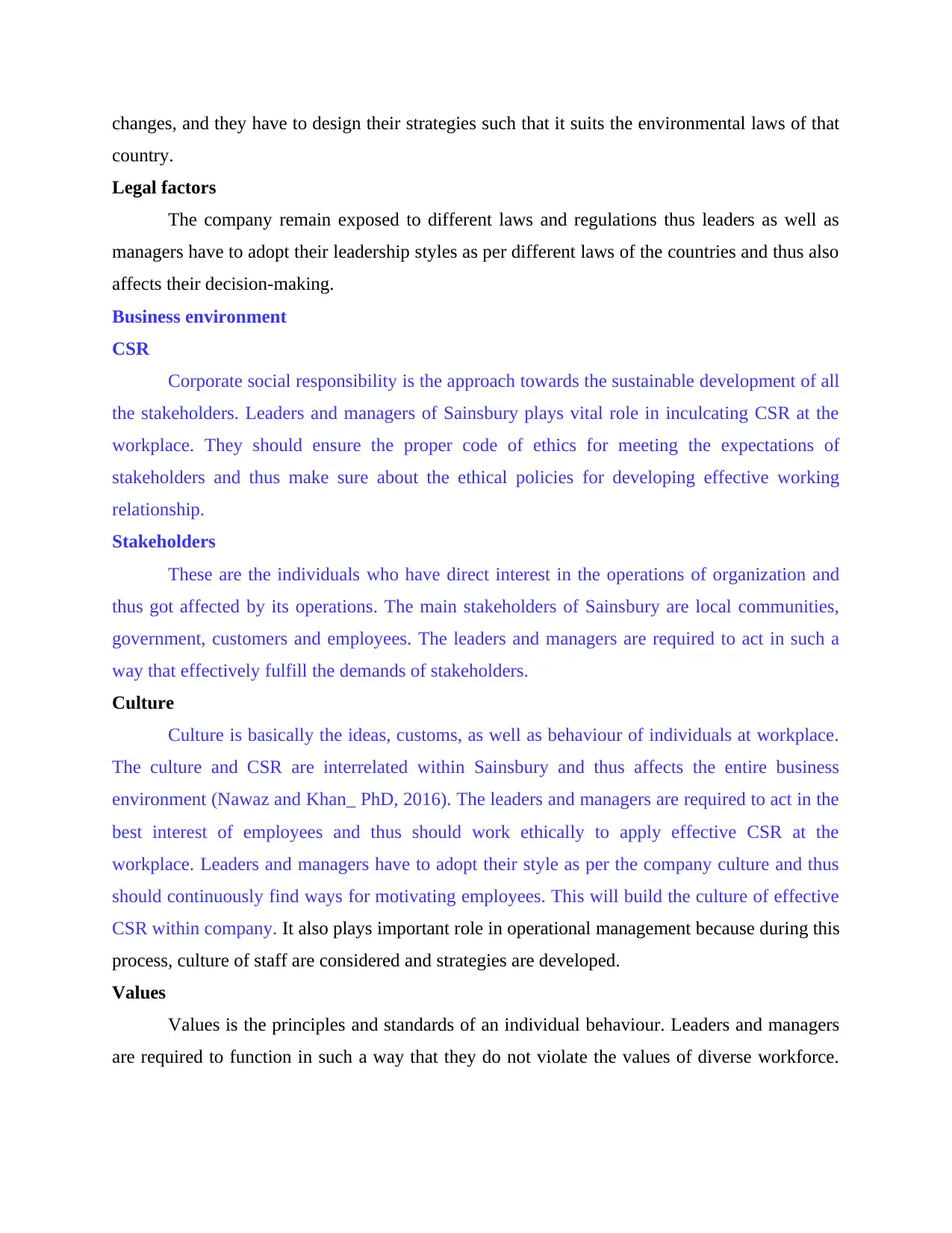
changes, and they have to design their strategies such that it suits the environmental laws of that
country.
Legal factors
The company remain exposed to different laws and regulations thus leaders as well as
managers have to adopt their leadership styles as per different laws of the countries and thus also
affects their decision-making.
Business environment
CSR
Corporate social responsibility is the approach towards the sustainable development of all
the stakeholders. Leaders and managers of Sainsbury plays vital role in inculcating CSR at the
workplace. They should ensure the proper code of ethics for meeting the expectations of
stakeholders and thus make sure about the ethical policies for developing effective working
relationship.
Stakeholders
These are the individuals who have direct interest in the operations of organization and
thus got affected by its operations. The main stakeholders of Sainsbury are local communities,
government, customers and employees. The leaders and managers are required to act in such a
way that effectively fulfill the demands of stakeholders.
Culture
Culture is basically the ideas, customs, as well as behaviour of individuals at workplace.
The culture and CSR are interrelated within Sainsbury and thus affects the entire business
environment (Nawaz and Khan_ PhD, 2016). The leaders and managers are required to act in the
best interest of employees and thus should work ethically to apply effective CSR at the
workplace. Leaders and managers have to adopt their style as per the company culture and thus
should continuously find ways for motivating employees. This will build the culture of effective
CSR within company. It also plays important role in operational management because during this
process, culture of staff are considered and strategies are developed.
Values
Values is the principles and standards of an individual behaviour. Leaders and managers
are required to function in such a way that they do not violate the values of diverse workforce.
country.
Legal factors
The company remain exposed to different laws and regulations thus leaders as well as
managers have to adopt their leadership styles as per different laws of the countries and thus also
affects their decision-making.
Business environment
CSR
Corporate social responsibility is the approach towards the sustainable development of all
the stakeholders. Leaders and managers of Sainsbury plays vital role in inculcating CSR at the
workplace. They should ensure the proper code of ethics for meeting the expectations of
stakeholders and thus make sure about the ethical policies for developing effective working
relationship.
Stakeholders
These are the individuals who have direct interest in the operations of organization and
thus got affected by its operations. The main stakeholders of Sainsbury are local communities,
government, customers and employees. The leaders and managers are required to act in such a
way that effectively fulfill the demands of stakeholders.
Culture
Culture is basically the ideas, customs, as well as behaviour of individuals at workplace.
The culture and CSR are interrelated within Sainsbury and thus affects the entire business
environment (Nawaz and Khan_ PhD, 2016). The leaders and managers are required to act in the
best interest of employees and thus should work ethically to apply effective CSR at the
workplace. Leaders and managers have to adopt their style as per the company culture and thus
should continuously find ways for motivating employees. This will build the culture of effective
CSR within company. It also plays important role in operational management because during this
process, culture of staff are considered and strategies are developed.
Values
Values is the principles and standards of an individual behaviour. Leaders and managers
are required to function in such a way that they do not violate the values of diverse workforce.
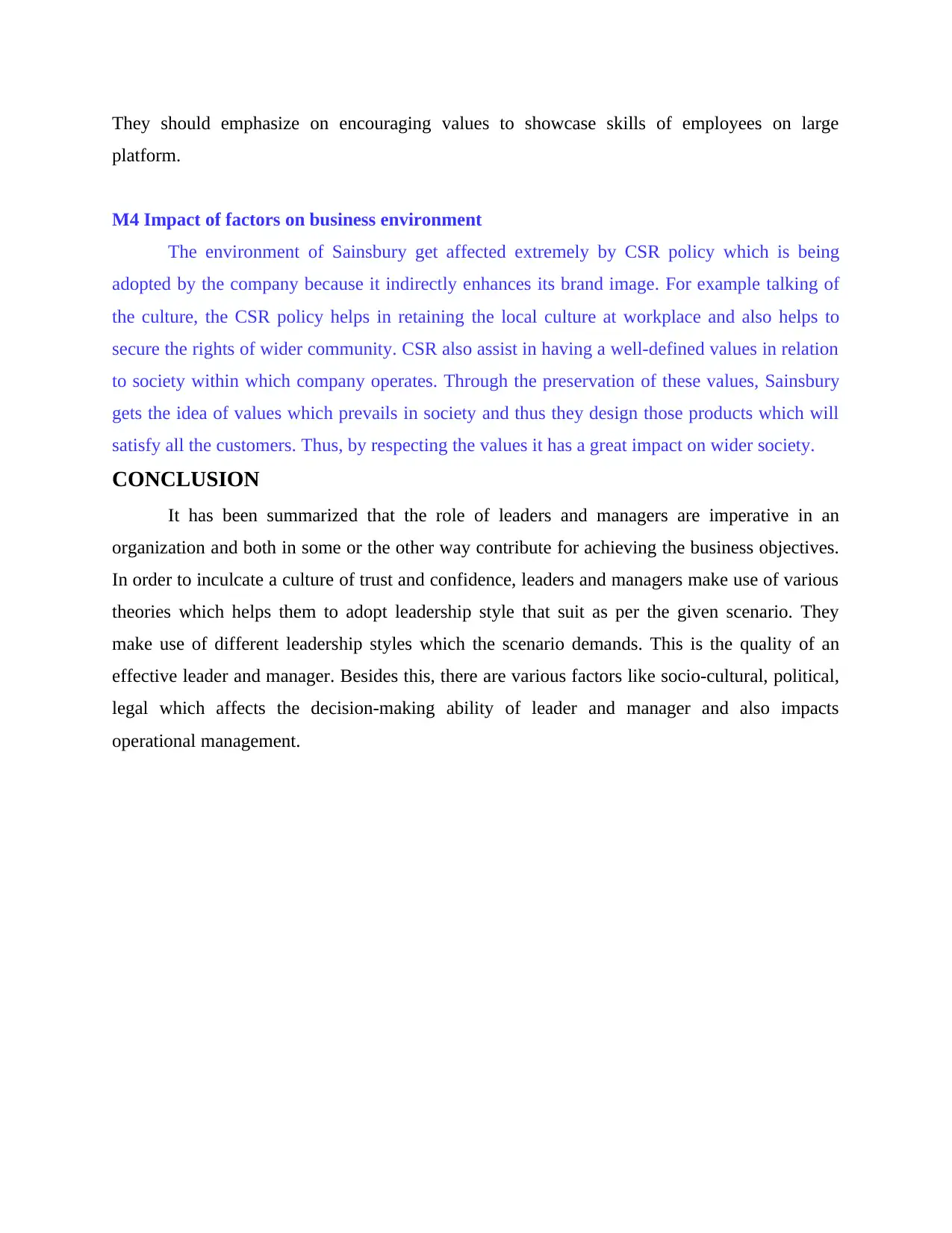
They should emphasize on encouraging values to showcase skills of employees on large
platform.
M4 Impact of factors on business environment
The environment of Sainsbury get affected extremely by CSR policy which is being
adopted by the company because it indirectly enhances its brand image. For example talking of
the culture, the CSR policy helps in retaining the local culture at workplace and also helps to
secure the rights of wider community. CSR also assist in having a well-defined values in relation
to society within which company operates. Through the preservation of these values, Sainsbury
gets the idea of values which prevails in society and thus they design those products which will
satisfy all the customers. Thus, by respecting the values it has a great impact on wider society.
CONCLUSION
It has been summarized that the role of leaders and managers are imperative in an
organization and both in some or the other way contribute for achieving the business objectives.
In order to inculcate a culture of trust and confidence, leaders and managers make use of various
theories which helps them to adopt leadership style that suit as per the given scenario. They
make use of different leadership styles which the scenario demands. This is the quality of an
effective leader and manager. Besides this, there are various factors like socio-cultural, political,
legal which affects the decision-making ability of leader and manager and also impacts
operational management.
platform.
M4 Impact of factors on business environment
The environment of Sainsbury get affected extremely by CSR policy which is being
adopted by the company because it indirectly enhances its brand image. For example talking of
the culture, the CSR policy helps in retaining the local culture at workplace and also helps to
secure the rights of wider community. CSR also assist in having a well-defined values in relation
to society within which company operates. Through the preservation of these values, Sainsbury
gets the idea of values which prevails in society and thus they design those products which will
satisfy all the customers. Thus, by respecting the values it has a great impact on wider society.
CONCLUSION
It has been summarized that the role of leaders and managers are imperative in an
organization and both in some or the other way contribute for achieving the business objectives.
In order to inculcate a culture of trust and confidence, leaders and managers make use of various
theories which helps them to adopt leadership style that suit as per the given scenario. They
make use of different leadership styles which the scenario demands. This is the quality of an
effective leader and manager. Besides this, there are various factors like socio-cultural, political,
legal which affects the decision-making ability of leader and manager and also impacts
operational management.
⊘ This is a preview!⊘
Do you want full access?
Subscribe today to unlock all pages.

Trusted by 1+ million students worldwide
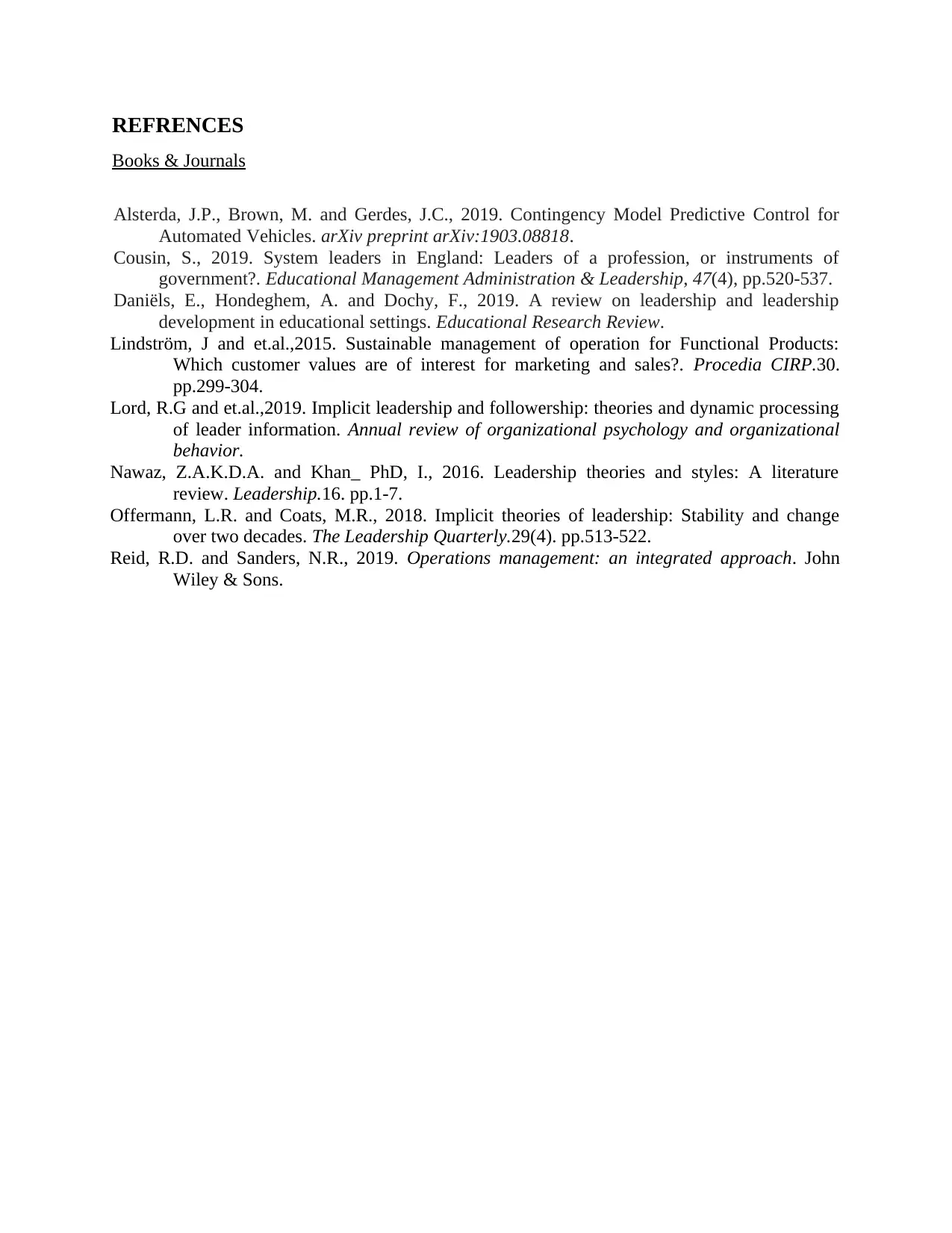
REFRENCES
Books & Journals
Alsterda, J.P., Brown, M. and Gerdes, J.C., 2019. Contingency Model Predictive Control for
Automated Vehicles. arXiv preprint arXiv:1903.08818.
Cousin, S., 2019. System leaders in England: Leaders of a profession, or instruments of
government?. Educational Management Administration & Leadership, 47(4), pp.520-537.
Daniëls, E., Hondeghem, A. and Dochy, F., 2019. A review on leadership and leadership
development in educational settings. Educational Research Review.
Lindström, J and et.al.,2015. Sustainable management of operation for Functional Products:
Which customer values are of interest for marketing and sales?. Procedia CIRP.30.
pp.299-304.
Lord, R.G and et.al.,2019. Implicit leadership and followership: theories and dynamic processing
of leader information. Annual review of organizational psychology and organizational
behavior.
Nawaz, Z.A.K.D.A. and Khan_ PhD, I., 2016. Leadership theories and styles: A literature
review. Leadership.16. pp.1-7.
Offermann, L.R. and Coats, M.R., 2018. Implicit theories of leadership: Stability and change
over two decades. The Leadership Quarterly.29(4). pp.513-522.
Reid, R.D. and Sanders, N.R., 2019. Operations management: an integrated approach. John
Wiley & Sons.
Books & Journals
Alsterda, J.P., Brown, M. and Gerdes, J.C., 2019. Contingency Model Predictive Control for
Automated Vehicles. arXiv preprint arXiv:1903.08818.
Cousin, S., 2019. System leaders in England: Leaders of a profession, or instruments of
government?. Educational Management Administration & Leadership, 47(4), pp.520-537.
Daniëls, E., Hondeghem, A. and Dochy, F., 2019. A review on leadership and leadership
development in educational settings. Educational Research Review.
Lindström, J and et.al.,2015. Sustainable management of operation for Functional Products:
Which customer values are of interest for marketing and sales?. Procedia CIRP.30.
pp.299-304.
Lord, R.G and et.al.,2019. Implicit leadership and followership: theories and dynamic processing
of leader information. Annual review of organizational psychology and organizational
behavior.
Nawaz, Z.A.K.D.A. and Khan_ PhD, I., 2016. Leadership theories and styles: A literature
review. Leadership.16. pp.1-7.
Offermann, L.R. and Coats, M.R., 2018. Implicit theories of leadership: Stability and change
over two decades. The Leadership Quarterly.29(4). pp.513-522.
Reid, R.D. and Sanders, N.R., 2019. Operations management: an integrated approach. John
Wiley & Sons.
Paraphrase This Document
Need a fresh take? Get an instant paraphrase of this document with our AI Paraphraser


⊘ This is a preview!⊘
Do you want full access?
Subscribe today to unlock all pages.

Trusted by 1+ million students worldwide
1 out of 12
Related Documents
Your All-in-One AI-Powered Toolkit for Academic Success.
+13062052269
info@desklib.com
Available 24*7 on WhatsApp / Email
![[object Object]](/_next/static/media/star-bottom.7253800d.svg)
Unlock your academic potential
Copyright © 2020–2025 A2Z Services. All Rights Reserved. Developed and managed by ZUCOL.





